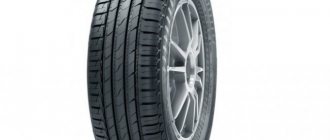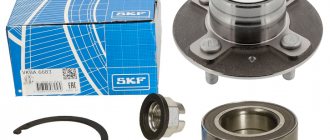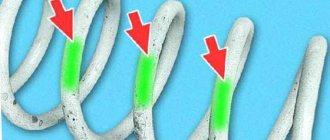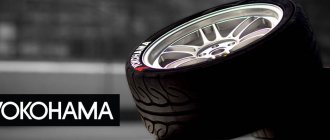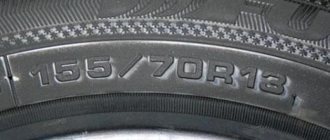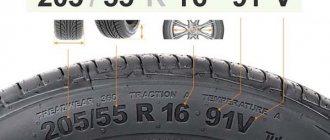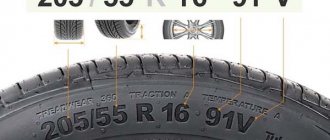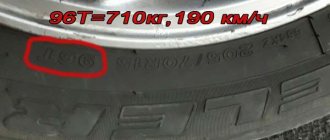Naturally, sellers, whether it is used or new material, will, of course, say the year is newer than it actually is. And here you only need to rely on yourself to understand how old the tires actually are.
We will tell you how you can determine the age of car tires and what methods exist for this.
How many years can you drive on summer tires?
Tire service life – 10 years
from the date of production (during this period the tires ensure safe operation in the absence of damage and compliance with the required remaining tread depth).
The warranty period is 5 years
from the date of production of the tire, but no more than 2
years
from the date of delivery of the tires to the consumer.
Interesting materials:
How to delete business chats in Viber? How to delete a business page on Facebook? How to remove bluetooth from a car? How to remove Bluetooth from Xiaomi device? How to delete a blog on Instagram? How to delete a block in AutoCAD that cannot be deleted? How to remove adblock ad blocker? How to remove a bot from a telegram group? How to remove a bot from a telegram group? How to delete a bot in telegram?
How to determine the year of manufacture of tires
Different countries have their own markings that determine the production date of car tires.
However, in the early 2000s, manufacturers began to adhere to common standards. This has become a necessity due to the proliferation and mixing of products. For example, for foreign brands Kumho, Yokohama, Dunlop, Pirelli, special markings are installed where the exact data is encrypted. Recently, other manufacturers have joined the general standards:
- Nordman;
- Matador;
- Dunlop;
- Ice Cruiser;
- Rosava.
- And others.
The following is a more accurate determination of the production time of tires from popular manufacturers.
Tire release date: where indicated
According to the regulatory documents of the Department of Transportation, all manufacturers of automobile tires are required to mark the production date on their products. The code should be separated from other designations, which makes it stand out for better identification. The organization's requirements say that for this index it is necessary to choose a place on the side of the rubber, in a place visible to the buyer, therefore, the index must be looked at on the sides. However, the exact location is not specified; brands have the right to place indexes at their discretion.
For models from manufacturers such as Goodyear, Michelin, Nokian, the location of the encoding in a separate oval is relevant. The index consists of 4 digits, which makes it easier to find and decipher. For example, you can take Nokian Hakapelita tires of 7/5/8 generations.
In this case, you can see that the index is highlighted with a rubber oval, the numbers stand out among the general designations.
You can also find products on the market with strange indices like YYY 2015/2117 and others. You can find it on the side parts of the tire.
These are typical identifiers for the Yakohama brand.
The following designation can be found from Goodyear:
As you can see from the photo, the code numbers are not surrounded by rubber circles or squares, but are simply written during vulcanization.
Marking the production date of tires and deciphering their designations
As of 2022, there is a generally accepted marking of the production date of automobile tires according to the DOT code. At the same time, the rules are the same for cars, truck tractors and buses.
The side parts on tires of the brands Bridgestone, Michelin, Toyo, Kama contain the so-called DOT coding. The index itself consists of several characters, but in this case the buyer should be interested in the last 4 digits.
The photo shows the standard marking, where the first two digits “31” indicate the calendar week, and “03” the year. Thus, it can be deciphered that the above tire was released in August 2003.
Weekly allocations are taken into account in accordance with the ISO 8601 regulation, where calendar allocations are strictly broken down into weekly basis.
Also on some modifications of rubber you can find a designation like “YYY2018” and similar. This is especially often indicated for Yokohama brand products. You should not be afraid when you encounter this marking. The first three letters are not taken into account, the numbers are interesting - 2022 tells the buyer that the product was released from the assembly line in the 20th week of 2022.
“In the bins” of some unique stores you can still find wheels with three-digit indices such as 125 or 129. This is the standard marking of parts manufactured before 2000. However, there is no distribution of winter or summer tires.
There is also a definition of the week and year of issue. To accurately understand the situation, you need to pay attention to the place after the last number. For example, if there is a space or a triangular symbol after the code, this indicates the 90s, and if there are no extraneous marks, the model was released in the 80s.
Sellers' tricks
Often when selling, we can see tires neatly stacked on racks. However, before that, they traveled for a long, long time in a railway carriage, stacked in piles. Sellers, of course, won't tell you about this.
Next, imagine the situation that the summer season has ended, but there are still summer tires in the warehouse. What to do? After all, we need to make room for winter tires! Summer tires will simply be removed from the racks and thrown, at best, into the snow under a canopy. The same thing will happen with winter ones at the end of the season. This batch will then be sold at reduced prices at the beginning of the season as a new collection or new arrival.
In Europe, tires are stored for no more than five years. After this, they will be sent to Russia or other countries where, by law, the storage period is not so strictly regulated. This will usually also happen early in the season.
Refrain from buying winter tires before the start of winter or summer tires in early spring - it is quite possible that they will try to sell you an expired tire.
Instructions for determining production time
For example, you can take a standard tire from a European brand. Here you can determine the production time in this way.
- Carefully examine the sidewalls of the rubber and find the DOT combination.
- This strip may contain numbers, letters and other symbols.
- You need to move to the end of the line, where you highlight the last 4 digits.
- The first two talk about the week, and the last two talk about the year when the product left the assembly line.
Summary
As it becomes clear, there are quite a few ways to find out the age of Michelin car tires. The most important thing is to try to determine the age as approximately as possible, since the exact age is very, very difficult to determine, especially if the car tires have already been used by some driver before.
The most important thing to pay attention to when determining age is determining the tread height of Michelin tires. To do this, it is enough to measure this value as accurately as possible and compare it with the standard value. If the difference between these values is relatively small, then the age of such tires will also be small. As this value increases, the age of car tires will correspondingly increase.
The most important thing for drivers is to try to maintain the quality of the Michelin tires they use for as long as possible. To do this, it is enough to treat rubber products as carefully and carefully as possible.
Tired of paying fines? There is an exit!
Forget about fines from cameras! An absolutely legal new product - Traffic Police Camera Jammer, hides your license plates from the cameras that are installed in all cities. More details at the link.
- Absolutely legal (Article 12.2);
- Hides from photo and video recording;
- Suitable for all cars;
- Works through the cigarette lighter connector;
- Does not cause interference to radios and cell phones.
American labeling system
The above is the European notation system. American markings are applied in accordance with the quality standards of the US Department of Transportation. Such tires are produced for use in the North American states. All designations are expressed in inches.
Marking 31 X 10.5 R 15
31 — Tire outer diameter
10.5 — Section size
R — Radial arrangement of cord threads
15 — Bore diameter
Tire aging
The date of manufacture of a tire can be a determining factor when purchasing shoes for a car.
Each rubber has its own shelf life. Even if the tire mileage is extremely low, you cannot drive on one set for the rest of your life. Over time, tires are exposed to the destructive effects of the environment. The sulfur compounds inside the mixture are destroyed, and the tread itself becomes less elastic. Such tires lose their properties and the rubber simply refuses to provide the proper level of grip on the road.
Independent researchers analyzing serious accidents in several European countries have found a very interesting fact. Most accidents are caused by cars with old tires. Regardless of how famous the manufacturer is, any Bridgestone, Nokian, Yokohama or Dunlop tires have a certain lifespan. The average value is 6-7 seasons, although the French manufacturer Michelin gives a more optimistic forecast at 8-9 years at constant standard loads.
Standard bridgestone or Goodyear summer tires can last 7-8 years under normal driving conditions. A regular tire contains special softeners, which, with constant exposure, prevent the rubber from hardening and prevent cracks from appearing. However, this is relevant if the tire is used regularly. Therefore, if you bought wheels that were produced 4-5 years ago for constant driving, then it is quite possible to use them for another four seasons. If you have to drive infrequently, it is better to look towards tires with a more recent release date.
If we are talking about high-speed yokohama or dunlop tires, then the date of manufacture has more weight. Rubber that experiences high speed loads loses its properties faster. Therefore, it is advisable to change such tires every 3-4 seasons. This applies to products with speed index H and higher.
To determine the speed index on a tire, you should look at the sidewall. The year of manufacture is written on the inside of the wheels, and on the outer diameter there is a load index along with the speed category. The letters H, V, W or Y indicate high speed loads. These letters correspond to maximum speeds of 210, 240, 270 or 300 km/h, respectively. Such kits should be changed more often.
Winter tires have an additional pictogram in the form of a snowflake or the Latin letter W, which stands for Winter. The winter tire mixture consists of softer varieties. These wheels require more attention. Due to the special composition, the shelf life of the tire is reduced to 4-5 years. These parameters are recommended by leading manufacturers Michelin or Nokian, after which it is recommended to replace the kit.
It should be understood that the year of manufacture of tires is not always an accurate indicator for changing shoes. Much depends on operating conditions. If you drive intensively, you can roll the kit in one season. An excellent indicator of tread wear are Twi marks applied around the entire circumference of the wheel. The deepest is at a tread height of 1.6 mm (for winter tires -2 mm) and is the minimum permissible.
Also, if tires have been stored incorrectly, their shelf life will also decrease. The question of how to properly store tires is also relevant. If the set does not have disks, then the wheels should be stored standing up, turning them over once a month. It is not recommended to hang the set, as constant pressure on the cord can damage its integrity. Tires and rims can be stacked horizontally on top of each other or suspended, but do not stack them vertically in the same position.
Tire storage
If car tires have not worn out ahead of time, then their service life (maintaining the declared driving characteristics) should be no less than five years. This is guaranteed by all well-known manufacturers. In practice, with proper care and careful use, tires are quite capable of lasting much longer than the specified minimum. At the same time, they can maintain both performance characteristics, elasticity, and appearance.
The aging of tires primarily depends on its quality. But this parameter is significantly influenced by the operating and storage conditions of the wheels. Over time, tires lose elasticity and become harder. This process is accelerated by exposure to high temperatures, direct sunlight, and moisture. Therefore, during the off-season, it is better to store tires packed in special plastic bags that prevent direct contact of the rubber with the external environment and direct exposure to ultraviolet radiation.
Beaded wheels should be stored inflated and hung on the walls of a dry and dark room (attic or garage), and tires removed from the rims should be stored in stacks or vertically. In the latter case, from time to time they need to be swapped or rotated. In addition, today many auto centers offer tire storage services, for which they have specialized premises equipped with special racks. With such storage and compliance with all rules, car tires can remain elastic for up to ten years.
Symbols related to tread pattern
According to the nature of the pattern, protectors are divided into:
- Non-directional. Symmetrical, relative to its longitudinal axis, or universal
- Directed. Symmetrical. They have recesses for better water drainage
- Asymmetrical. Combines several useful properties. The outer side can provide better grip on dry surfaces, and the inner side can work to drain water
When installing wheels, the following designations are taken into account:
Outside - The outer side of an asymmetric tire
Inside - The inner side of the asymmetrical wheel
Rotation - This inscription in conjunction with an arrow indicates the direction of movement of the wheel. This indicates that the tread is directional. If installed incorrectly, water accumulates in the tread grooves, which creates conditions for hydroplaning.
Size determination
The main thing you need to pay attention to when choosing a tire is the size. This is the largest image after the manufacturer's name.
205 — Width of the tire section in mm. Linear distance between sidewalls. The tire is measured when inflated. Protruding parts of the markings are not taken into account when measuring.
65 — Profile height. Relative value, calculated as a percentage. It is the ratio of the profile height to the section width. Profile height is the distance between the landing and outer diameters. The seat diameter is determined at the point where the tire is attached to the wheel rim.
The profile height is not indicated in the marking if its value is more than 80%. Starting from 75% onwards (5% step: 75, 70, 65...) must be applied. The larger the value, the higher the tire looks.
A tire with a height rating of 55 and below is classified as low profile. This tire has an increased tread width. Rubber gives the car sporty dynamics. Increases lateral stability during sharp turns. Reduces braking distance. It is not suitable for our road conditions because it is sensitive to road surface unevenness and cannot be used in bad weather conditions. On a wet surface, the risk of water drift increases significantly. In our conditions, it is recommended to use tires with a profile height of 70%.
R - Indicates the radial type of cord construction.
15 — Wheel rim diameter. Indicator in inches.
94 — Index of maximum load on one wheel. Expressed in kg. Reflects the critical mass at which the vehicle should not be operated. Mark 94 corresponds to a maximum weight of 670 kg.
N - Symbol of speed. Indicates the maximum threshold, exceeding which is prohibited. H corresponds to 210 km/h.
Size indicators are the main information that is used when choosing tires.
Large letters on the sidewall indicate the name of the manufacturer Bridgestone and the tire model.
Important information
Tires are available in tubed and tubeless versions. Tubeless ones are mounted on reinforced rims with more reliable fastening elements.
Bridgestone tires are classified according to their purpose:
- Road or summer. Designed for use at temperatures above +5 o C. Provide good adhesion to dry and wet surfaces. They perform worst on dirt roads. Not suitable for icy or snowy areas.
- Winter. In terms of dynamic properties they are inferior to summer ones. Adapted for movement on slippery, snowy areas. There is a possibility of additional studding of the tread.
- All-season. They can be used in summer and winter, but their grip characteristics are inferior to seasonal tires.
- Universal. Installed on SUVs. They hold traction well and provide cross-country ability on both dirt roads and asphalt surfaces.
- Special tires with improved cross-country ability. Allows you to move on soft ground and in off-road conditions. Installed on special equipment.
Special markings are used to indicate seasonality.
Useful tips
And in the end, we will give some useful tips that will help extend the service life and reduce the aging of car tires:
- Do not store tires without special bags; they protect the tire well from premature aging.
- Do not store tires in a place where they are exposed to direct sunlight and heat. Solar radiation is one of the main factors of aging.
- Try to park the car in the shade from the sun if possible. This will not only reduce the aging process of rubber, but also protect the car’s paintwork and interior parts from fading.
- Monitor your tire pressure. Incorrect tire pressure can cause the tire to overheat and wear out.
- Make sure your tires wear evenly. If you see that the tires are wearing unevenly on different sides, then you need to urgently go to a technical station and have a wheel alignment done. If in such a situation you simply buy and install new tires, then you will immediately ruin them, since they will also wear unevenly.
Good luck on the roads!
Material prepared by Pokrishka.ru
Attention! All contents of this site are protected by intellectual property legislation (Rospatent, registration certificate No. 2006612529). Installing a hyperlink to site materials is not considered a violation of rights and does not require approval. Legal support of the site - legal..
CONCLUSION
From all of the above, the following conclusions can be drawn:
- When buying new or used tires, pay attention to the year of manufacture of the product.
- You can find out the year of manufacture of the tire by the digital marking in the oval sector, after the DOT code.
- The guaranteed shelf life of tires should not exceed 5 years.
- Tires can be used after the expiration of the warranty storage period, but with mandatory diagnostics at least once a season.
- When choosing rubber within a 3-5 year shelf life, pay attention to the appearance of the product.
Determining the expiration date of a tire
Specific dates depend on the quality of the material and storage conditions. For example, the ideal warehouse environment is a dry workshop with no temperature changes, minimal dampness and no direct sunlight. If all parameters are met, the product can be stored for 7-8 and 4-5 years for summer and winter tires, respectively.
More accurate studies were carried out by MICHELIN, Continental and others. Artificial tests confirmed these results and showed that a tire that had been in a warehouse for 2-3 years practically does not differ from a fresh one in terms of characteristics. In 2022, you can take products released after 2014-15. And for products from 2012, the critical moment of write-off has already arrived.
Moreover, the data is relevant exclusively for branded products such as Blizzak Spike 01, Goodyear, Hankuk and analogues of Japanese or European production.
For simple modifications, it is necessary to revise the deadlines downward. At the same time, it is difficult to determine because cheap tires may not be equipped with dates. Therefore, it is necessary to carefully review such factors.
- Appearance – fresh rubber of a rich, black color, no whitish tint or coating.
- The material is soft, elastic, the structure is homogeneous.
- There are no small cracks or tears on the walls and tread of the product.
If all parameters are met, you can ride on the wheel.
Tire design
To understand the marking designation, you need to have an understanding of the tire design.
Tire components:
The frame is the load-bearing part of the tire. Consists of several layers of cord.
Each layer is a rubberized synthetic fabric made of thick threads located in the radial direction and thin threads intertwining the radials. The reinforced frame structure contains metal threads. These tires are installed on trucks and minibuses.
The cord layers that make up the breaker are located between the base and the tread. The breaker dampens vibration and shock when moving.
The tread is the part of the tire that is in contact with the road. A pattern is applied to the tread that determines the traction properties of the tire.
The segment of the tire by which it is attached to the wheel is called the bead.
Sidewall - protects the internal structure from external influences. The marking is applied to the sidewall of the tire.


